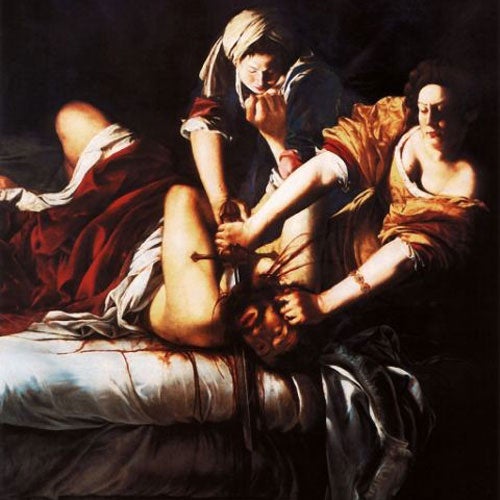Great Works: Judith Slaying Holofernes, circa 1614-20, Artemisia Gentileschi
Uffizi Gallery, Florence

Your support helps us to tell the story
From reproductive rights to climate change to Big Tech, The Independent is on the ground when the story is developing. Whether it's investigating the financials of Elon Musk's pro-Trump PAC or producing our latest documentary, 'The A Word', which shines a light on the American women fighting for reproductive rights, we know how important it is to parse out the facts from the messaging.
At such a critical moment in US history, we need reporters on the ground. Your donation allows us to keep sending journalists to speak to both sides of the story.
The Independent is trusted by Americans across the entire political spectrum. And unlike many other quality news outlets, we choose not to lock Americans out of our reporting and analysis with paywalls. We believe quality journalism should be available to everyone, paid for by those who can afford it.
Your support makes all the difference.Even as we admire the overwhelming virtuosity of this 17th-century masterpiece, and luxuriate in the sheer magnificence of its painted surfaces – the warmth and fullness of those flesh tones, for example, the rendering of fabrics in crimson and gold – we also recoil in horror at the clinical brutality of its theme.
It is nothing more nor less than the story of the studiedly brutal decapitation of a drunken, bearded man who appears to be conscious and horrifyingly a witness – the eyes are open, the lips parted to reveal a gleam of teeth, the brow furrowed – to what is happening to him, even as his head is being severed from his neck (the sumptuous blade saws and slides, back and forth) by a woman, steely of purpose, powerful of arm, who is in the business of doing nothing other than exact the final revenge upon him for who he happens to be – the general of an invading army. She is determined to take off that head at the perfect angle, expeditiously. This is why, with her left hand – see how her lower arm, at full stretch, has been spattered by a spray of blood from the neck – she must wrench that head back, and then to the side. Does she have hold of his ear to get the leverage she requires? The single most visually dramatic feature of the entire painting is that spray of crimson blood from the jugular, which seems to rhyme with the crimson of the fabric across his middle. See how the jet seems to rise up in a firework-like curve of red, silken threads.
There are no visual diversions of any kind. The turbaned female onlooker, too, is utterly absorbed in the killing of this man, leaning forward, helping to hold the struggling body down, and as he suffers, so his right arm rises up and his fist seems to be supporting her chin, as if to encourage her to ruminate upon the scene – a particularly macabre supposition. There is a mighty entanglement of arms. Other than this, the canvas is in darkness – in fact, the darkness seems to bear down upon the scene, enfolding it, as if to heighten its terrible theatricality. And in front of that darkness, as if set at the very front of the stage, there is this scene, lit so dramatically from the front in a way that can only be described as Caravaggesque. Who, as you may remember, was also a murderer.
Why though? Who? The Book of Judith will tell us. Judith, a widower, lives in a city under siege by the Assyrians. One night she steals out with her servant Abra, dressed in her finest, to murder the Assyrian general, Holofernes. She is doing it at Jehovah's behest. This is the terrible act she is committing here in this painting, though there is no hint of any spiritual dimension. It is all a brutal tussle between a strong man and two equally strong and determined women.
Biography worms its way into this troubling story. Artemisia Gentileschi was one of four children, all painters. She was the most talented. The others were boys. She was raped by another painter. The rapist was pardoned by the Grand Duke of Tuscany. Ah, the amorality of aristocrats! Perhaps this terrible act has informed the way she has chosen to depict this theme. In fact, she painted the same theme twice. In the earlier version, the female assailant seems rather reluctant to commit murder. The Judith of our painting is going about her task with cold dispassion. Her rather unlovely face is set. What is more, she rather resembles the painter herself. That was not the case with the first version. What also rather shocks us about this painting is how such violence can take place amidst these lovely stuffs – the jewellery, the coverlet that is falling from the plumped mattresses of the bed. All this is redolent of high sophistication, not the brutal baseness of murder. How Janus-faced is man!
ABOUT THE ARTIST Artemisia Gentileschi (1593-1652) was the most accomplished female painter of the Italian Baroque. The daughter of a painter, she was raped by Agostino Tassi, a friend of her father's. A recent biography speculates that the rage contained in this painting is a direct expression of the fact that her rapist was pardoned by the Grand Duke of Tuscany. She is known for her fearlessly faithful depiction of women.
Join our commenting forum
Join thought-provoking conversations, follow other Independent readers and see their replies
Comments